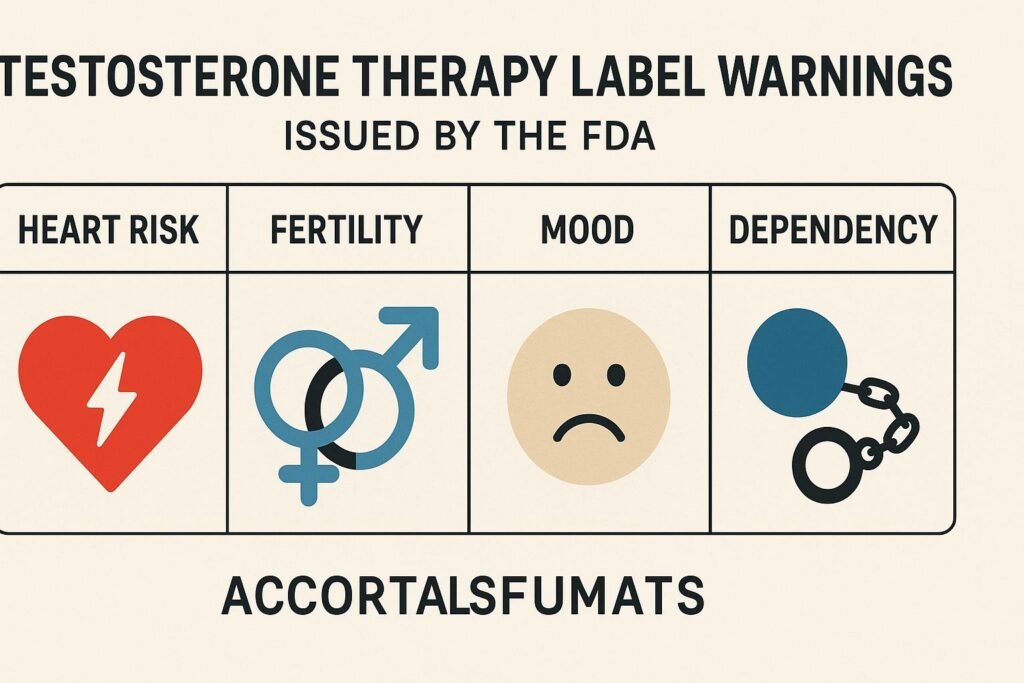Introduction
FDA testosterone label warnings may sound like something only a worried pharmacist would care about, but let’s get real, if you’re a man considering TRT, you’d better start caring too.
5 Proven Risks of TRT Clinics You Must Know Now
We live in a world where we scroll more than we sleep and trust Instagram reels more than medical journals. TRT? It’s become the new protein shake. Just slicker, pricier, and backed by your local “men’s clinic” that looks more like a spa than a medical facility.
But here’s the kicker: while influencers preach about gains and vitality, buried deep inside the packaging insert are warnings from the FDA that would make any man pause, if he ever actually read them.
You don’t need a white coat to understand the dangers. You need awareness, curiosity, and a healthy dose of scepticism. Because when it comes to your hormones, what you don’t know can hurt you, and shrink you (literally).
So before you hop on the weekly injection train, let’s take a hard look at the red flags printed right on the label.
When we talk about testosterone, most guys tune in with visions of energy, muscle, and libido. But almost no one reads the fine print. Especially the part stamped by the FDA.
FDA testosterone label warnings aren’t just legal fluff; they’re red flags. Ones that many clinics, influencers, and even some doctors conveniently ignore while pushing you toward the TRT hype train.
Let’s face it: nobody wants to read drug labels. They’re dense, clinical, and full of scary words. But buried inside them are truths every man deserves to know before he commits to external testosterone.
If you’re even thinking about TRT (Testosterone Replacement Therapy), this might be the most important thing you read today.
Table of Contents
Why This Matters Now
FDA testosterone label warnings are more than just bureaucratic fine print; they’re the alarm bells we’ve been trained to ignore. Testosterone isn’t just trending; it’s being marketed like a self-improvement subscription box. Instead of better skin and productivity, you’re playing with blood viscosity, organ stress, and reproductive shutdown.
Let’s be real: the average guy sees a testosterone ad and thinks, “Finally, a shortcut to being alpha.” What he doesn’t realise is that shortcuts often come with strings and syringes for life.
Testosterone prescriptions have quadrupled since the early 2000s. Yet, studies also show that up to 1 in 4 men on TRT didn’t need it clinically (JAMA Internal Medicine, 2017). That’s not medical progress, that’s marketing. JAMA Internal Medicine, 2017
And while clinics look like luxury spas, the long-term effects aren’t so glamorous. Stroke risk, fertility suppression, and psychological shifts aren’t footnotes; they’re foundational concerns.
The FDA has issued multiple safety communications over the past decade, warning about heart attacks, stroke, infertility, and long-term dependency. These aren’t fringe theories. They’re published in peer-reviewed journals, announced by regulatory bodies, and whispered between regretful ex-users who can’t restart their natural T anymore.
This isn’t an anti-TRT crusade. It’s a call for conscious choice. Because informed masculinity beats impulsive enhancement every time. Prescriptions have quadrupled since the early 2000s. Yet, studies also show that up to 1 in 4 men on TRT didn’t need it clinically (JAMA Internal Medicine, 2017).
And here’s the uncomfortable truth:
Most men trust their doctor, not realising many TRT clinics are just pharmacies with better lighting and Instagram ads.
Meanwhile, the FDA has issued multiple safety communications over the past decade, warning about stroke, heart attack, fertility issues, and dependency.
This isn’t anti-TRT. It’s pro-informed-decision.
So, before you roll up your sleeve for that weekly injection, let’s decode the 4 FDA label warnings hiding in plain sight.
Warning #1: Cardiovascular Risk
What it is: Increased risk of heart attack, stroke, and blood clots, especially in older men or those with underlying heart conditions.
Why it matters: Testosterone thickens your blood (raises hematocrit), which can make your blood stickier and more prone to clotting.
FDA note: In 2015, the FDA required all prescription testosterone products to include warnings about heart-related risks.
What they don’t say loudly: Even younger men with high doses or long-term use can be affected. Elevated red blood cell count may sound like a gym bro bonus, but it’s a cardiovascular time bomb.
2015 FDA communication on testosterone risks
Warning #2: Fertility Suppression
What it is: External testosterone shuts down your natural T production, including sperm generation.
Why it matters: Your body sees external T and says, “Cool, we don’t need to make any more.” Which tanks your own supply.
FDA label fine print: Use of testosterone can lead to azoospermia (zero sperm) and shrinkage of testicles.
Reality check: That’s not just a side effect. That’s chemical castration if you’re not careful, and it’s rarely mentioned during the sales pitch.
Warning #3: Psychological Effects
What it is: Mood swings, aggression, irritability, and even suicidal thoughts in some users.
Why it matters: Hormones impact more than your muscles. They affect your brain chemistry, impulse control, and stress resilience.
FDA statement: Behavioural changes and psychiatric events have been reported with testosterone therapy use.
Red flag: Many clinics dismiss this as rare. But if your relationships feel tense, or you start snapping more than usual, you might want to pause and assess your protocol.
Warning #4: Dependency & Withdrawal

What it is: Your body gets used to synthetic testosterone and forgets how to function without it.
Why it matters: If you stop TRT suddenly, your natural T levels can crash hard. Think fatigue, depression, zero libido.
FDA caveat: Long-term use can lead to suppression of endogenous testosterone production.
Translation: Once you start, it’s hard to stop. And many men were never told it’s a lifelong commitment.
7 Savage Ways to Boost Testosterone Naturally Daily
Tools & Habits to Stay Informed

There’s nothing sexy about reading FDA databases or tracking safety alerts. But you know what’s less sexy? Getting blindsided by a heart scare or finding out your sperm count just ghosted you. These tools won’t flex your biceps, but they might save your future.
Think of them as your hormonal insurance. A man who tracks his decisions is a man in control, not just of his body, but of his direction.
- Tool: Drugs@FDA – Search database for all testosterone drug labels. Bonus: Find what your clinic didn’t bother to tell you.
- App: MedSafety App – Monitor real-time drug warnings and alerts. It’s like having an FDA watchdog in your pocket (without the barking).
- Reading: “Estrogeneration” by Dr. Anthony G. Jay – Understand the hormone disruptors you don’t hear about on TRT forums. Spoiler: they’re everywhere.
Daily habit: Before you inject anything, ask yourself: “Am I solving the root, or silencing the symptom?”
Because real strength isn’t found in a vial. It’s found in men who ask better questions and track better answers.
- Tool: Drugs@FDA – Search database for all testosterone drug labels
- App: MedSafety App – Monitor real-time drug warnings and alerts
- Reading: “Estrogeneration” by Dr. Anthony G. Jay – Understand the hormone disruptors you don’t hear about on TRT forums
Daily habit: Before you inject anything, ask yourself: “Am I solving the root, or silencing the symptom?”
FAQ
Q: Is testosterone therapy FDA-approved?
A: Yes, for men diagnosed with hypogonadism. But not for general fatigue, low libido, or ageing.
Q: Can I restart natural testosterone after quitting TRT?
A: It’s possible, but difficult. PCT (Post-Cycle Therapy) may help, but results vary.
Q: Are there safer alternatives to TRT?
A: Yes, lifestyle changes, supplements, stress control, and proper sleep can help many men restore their levels naturally.
Conclusion
There’s no shame in wanting to feel better, stronger, more alive. But there is a risk in outsourcing your biology to a prescription without reading the fine print.
FDA testosterone label warnings aren’t anti-testosterone, they’re pro-awareness.
If you still choose TRT, do it with full context, eyes open, and a backup plan.
And if you haven’t tried to optimise your lifestyle first…
Maybe it’s not your testosterone that’s low. Maybe it’s your standards.
Want to naturally restore your hormones?
Join the Masculine Routine Weekly for practical systems that build you from the inside out.
Suggested Articles
Read Next:
- 5 Proven Risks of TRT Clinics You Must Know Now
Exposes the hidden dangers of fast-growing TRT centres and why some may be more about profit than patient safety. - 7 Savage Ways to Boost Testosterone Naturally Daily
A testosterone-boosting listicle packed with gritty, actionable tips that work without needles or side effects. - The Masculine Discipline System: Daily Structure for Mental Sharpness
Reclaim your focus, energy, and drive through masculine routines that align with your biology and your mission. - 4 Powerful Breakfast Hacks That Promote Manly Hormones
Simple food swaps and timing strategies to kickstart your testosterone within the first hour of your day. - Discipline Over Motivation: A Masculine Framework That Actually Works
Forget waiting for motivation; build systems that reinforce masculine resilience and inner fire daily.


